You might have noticed the porterhouse steak at your local butcher counter that have a distinctive T-shaped bone. But the price is much higher than the similar-looking cuts labeled T bone steak.
What gives? Below we’ll compare the porterhouse vs T bone to help you make the right choice.
You might not be surprised to learn that both cuts originate from the same section of the cow. The naming distinction is defined by the USDA to help distinguish the thickness (and, presumably, the quality) of a cut.
If you’re anything like me, then you’re probably wondering if the extra quality is worth the high price. Right?
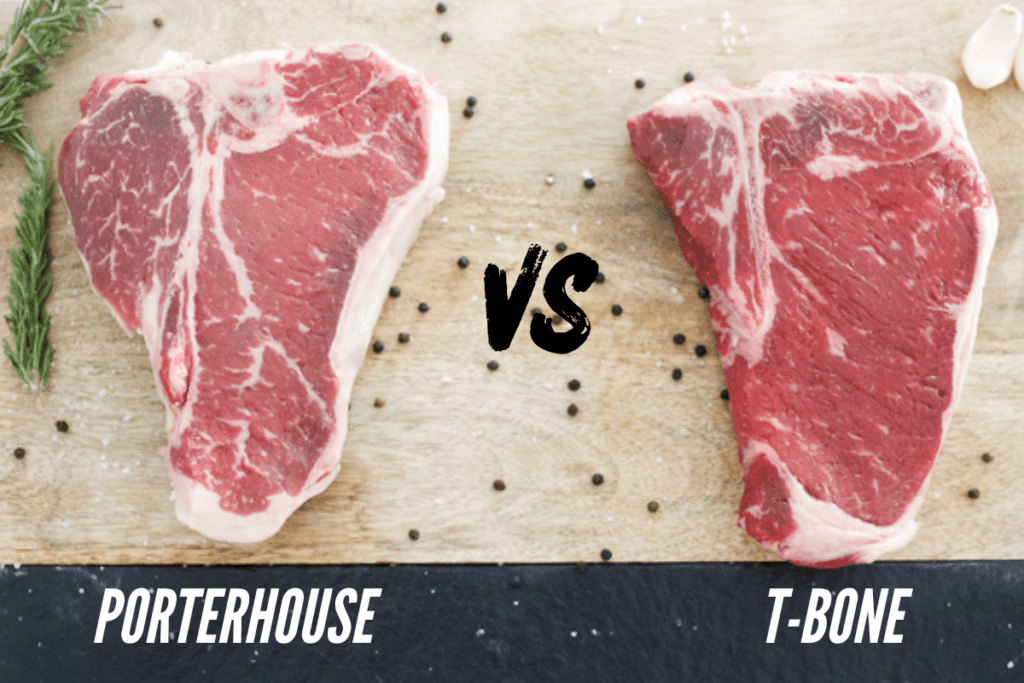
The truth is, it depends on what you plan to do with it. After 12 years in pro kitchens, including two that were Michelin starred, I’ve come to have some opinions on this matter.
In this article, I’ll explain the physical distinction of porterhouse vs T bone. We’ll also discuss practical and sensory differences you should consider when buying and cooking each.
Table of Contents
Porterhouse vs T Bone Cut Location – Short Loin
The physical distinction between these two steaks has everything to do with where the meat came from on the body of the cow. And, unless you’re a pro, the difference is subtle.
Both the porterhouse and the T bone come from a primal cut of the cow called the loin primal. This is an area just below the backbone toward the rear of the cow, but not quite to the rump.
Housed in the loin primal are two prominent subprimals: the short loin and the sirloin.
The short loin is a section of the cow made primarily of the cow’s lumbar vertebrae. When your butcher cuts a cross-section from the short loin, the vertebrae form the trademark “T.” You’ll find this feature on both the porterhouse and the T bone steak.
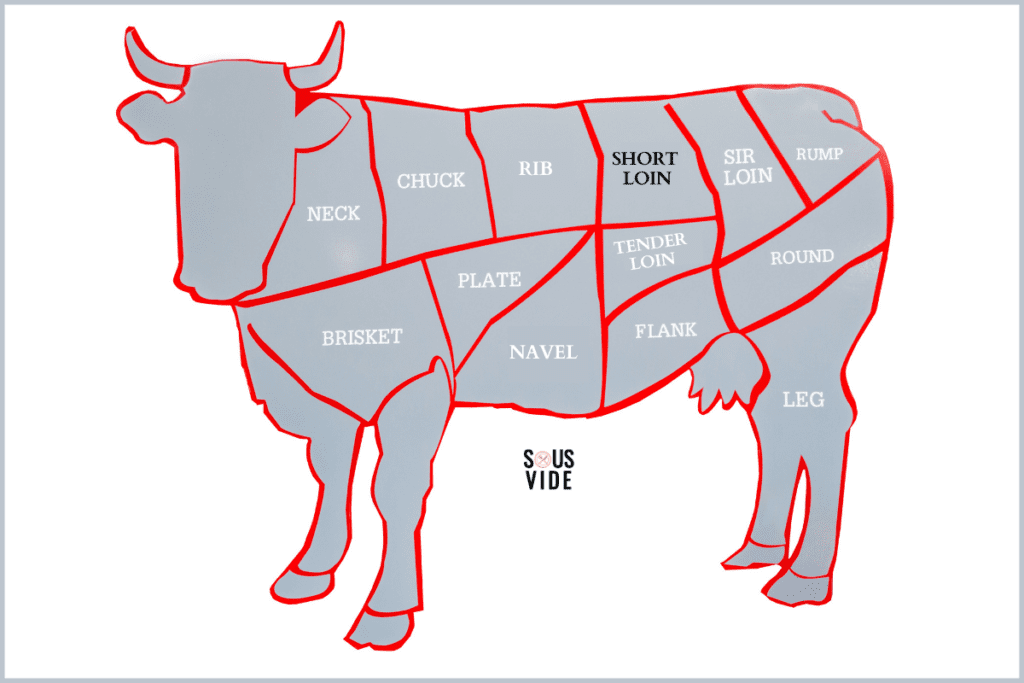
On one side of the “T,” the steak is a cross-section of the tenderloin muscle. And on the other side of the bone is what’s commonly called strip steak.
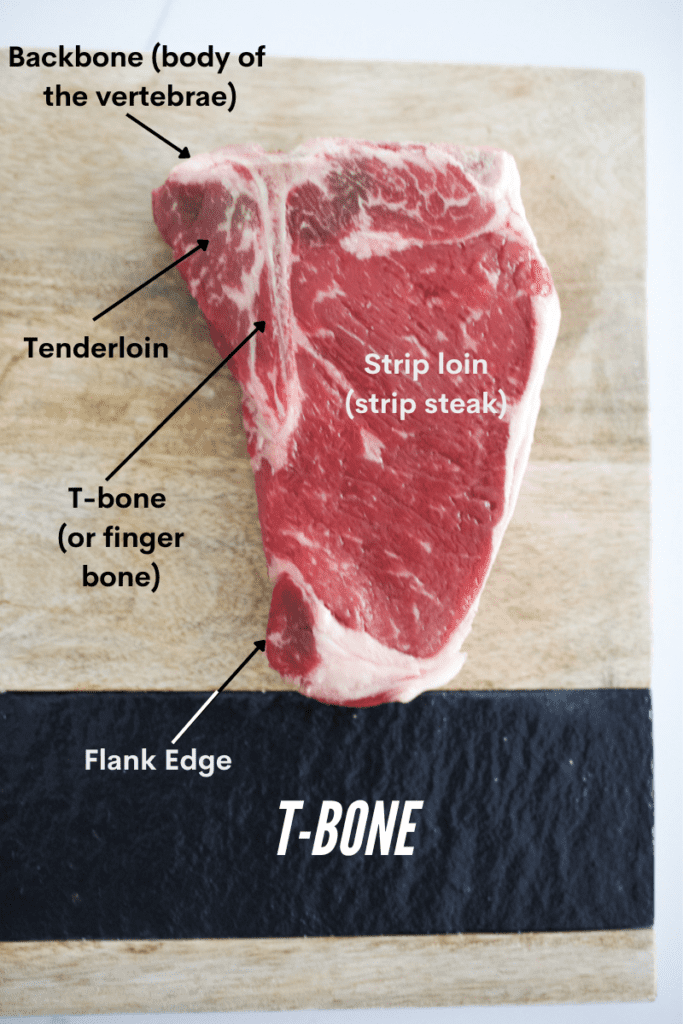
The Difference Between a Porterhouse and T Bone
The specific difference between T bone and porterhouse lies entirely in how close a particular cross-cut was made to the rear of the cow.
You see, the tenderloin muscle gets larger as it runs toward the hind section of the cow. And, according to the USDA, the tenderloin must be at least 1.25″ across to qualify as porterhouse. USDA is an acronym for United States Department of Agriculture, which amongst many things is the arbiter of all things meat product related.
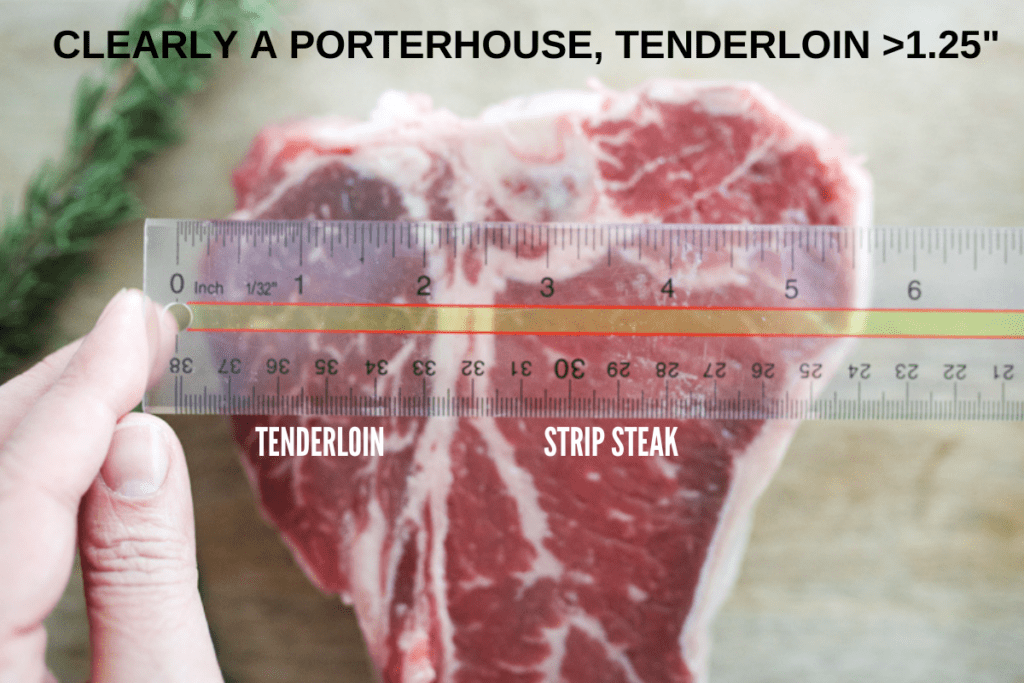
Short of that 1.25″, it’s simply a T bone steak. Well, technically the USDA would like you to know that the tenderloin must measure at least 0.25″ to be a T bone and not default to a bone in strip steak, which is also called a club steak.
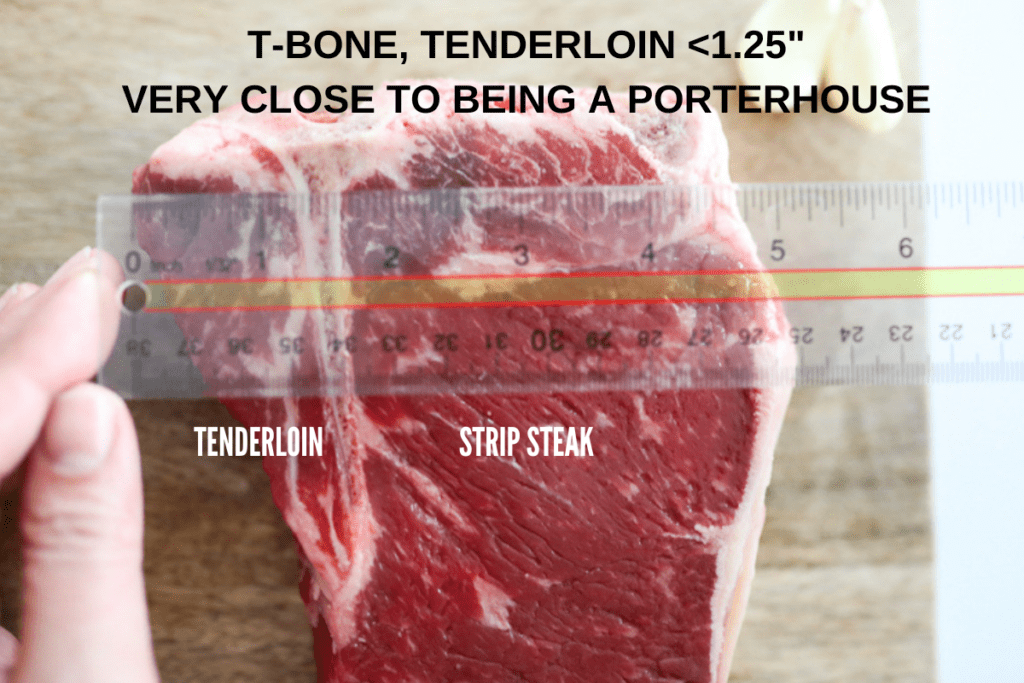
Prepare to be the life of the party when you share that all porterhouses are t-bones, but t-bones are not porterhouses. How do you like that deductive logic?
Marbling and Flavor Profiles
Marbling refers to the small streaks of fat contained in the muscle of the steaks.
Both the T bone and the porterhouse are naturally less marbled than, say, a ribeye steak. That means you’ll get less of a rich beefiness with these compared to other popular cuts.
The tenderloin side of the bone will always have less marbling than the strip steak.
Marbling does impact the flavor and moisture of the steak, so typically, the tenderloin can be affected by its lack of marbling. Filet mignon is a filet of the tenderloin. That is why bacon-wrapped filet mignons are commonly found on restaurant menus. Extra bacon fat compensates for the lack of marbling.
While marbling may impact flavor and moisture, it doesn’t have a direct effect on texture. In fact, what makes tenderloin so special is its texture.
The short loin is a relatively inactive body part during the cow’s life. Consequently, the muscles there are much more relaxed. From a culinary perspective, this makes them more tender.
Now, let’s switch gears to discuss the strip steak. I find this muscle contains all of the right characteristics to make it the perfect cut for most people.
Strip steak has more marbling than its tenderloin counterpart but much less than a ribeye. It offers an excellent combination of tender texture and impactful rich beefiness from some marbling.
The strip steak is also commonly called the New York strip steak and the Kansas City strip steak.
Related reading:
What’s More Expensive, Porterhouse or T-bone?
Just like the USDA sets a standard for how thick tenderloin must be to qualify for a Porterhouse, it does the same for filet mignon.
For a tenderloin to qualify as filet mignon, it needs to be between 1.5” and 2” thick.
This means that each Porterhouse, which is typically 1.5-2″ thick, contains one filet mignon and one strip steak. The T bone simply contains a smaller portion of filet mignon.
Since the porterhouse contains a much larger portion of the tenderloin, it will always be the pricier of the two cuts. This comes down to the tenderloin amounting to only 2-3% of the cow, which helps explain why the filet mignon is often the most expensive steak on the menu.
Even though it costs more, Porterhouse is a perfect option for a special occasion because you’ll get two excellent types of beef in a single package. In my opinion, it’s a great dinner for two. Just open your favorite bottle of red, and you’re on your way to a tasty evening.
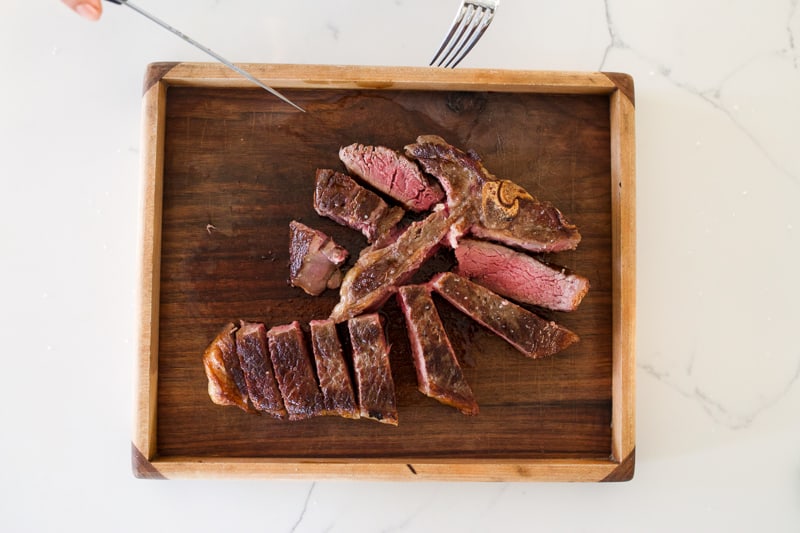
Best Cooking Methods for Porterhouse Steak and T-bone Steak
Both the T bone and porterhouse will do well under all the standard steak cooking techniques. Having the bone-in will help retain moisture and juiciness during cooking.
Try a well-seasoned, hot cast iron skillet for a nice hard sear. Then baste it with butter, aromatic herbs, and garlic.
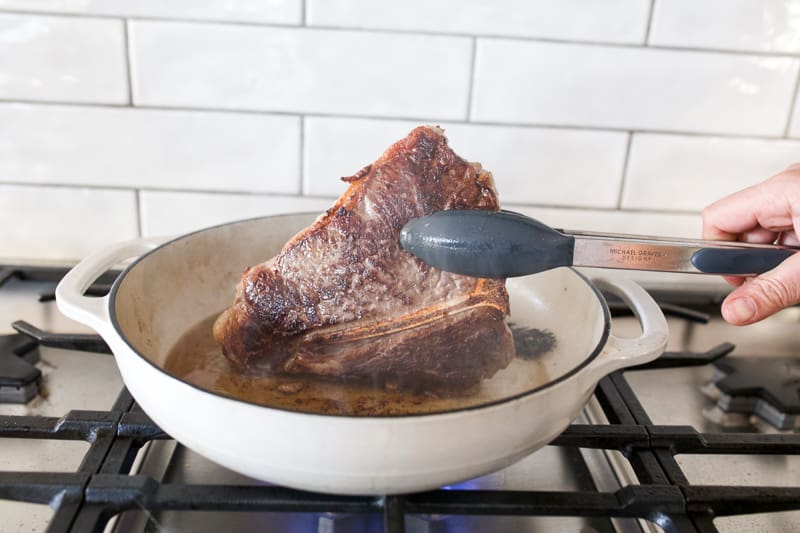
The two steaks will also do well over the grill.
Since you’ll be dealing with two separate cuts of meat, prioritize cooking time and temperature to your preferred cut. Either the strip steak or the filet mignon.
Do note that if you prioritize the strip steak and cook it to medium rare, then you’re likely to overcook the tenderloin. Since the filet mignon is much leaner, it will tend to cook faster. When I cook filet mignon on its own, I prefer to sous vide filet mignon to 127°F before searing.
I find cooking porterhouse and T bone steaks to an end temperature of 130°F, no matter the method, a happy compromise for both cuts of steak if you prefer your steaks medium-rare like I do.
If you really want to bring out the best of both worlds, take the cuts of steak off the bone of the Porterhouse and cook them separately, giving each cut the attention and care they both deserve. Just separately.
Given how small the filet is on the T bone, this probably isn’t worth the effort.
The best solution, though, is cooking sous vide to optimize for the texture of each steak. It will provide maximum control of cooking time and temperature, so you land at the precise doneness you love.
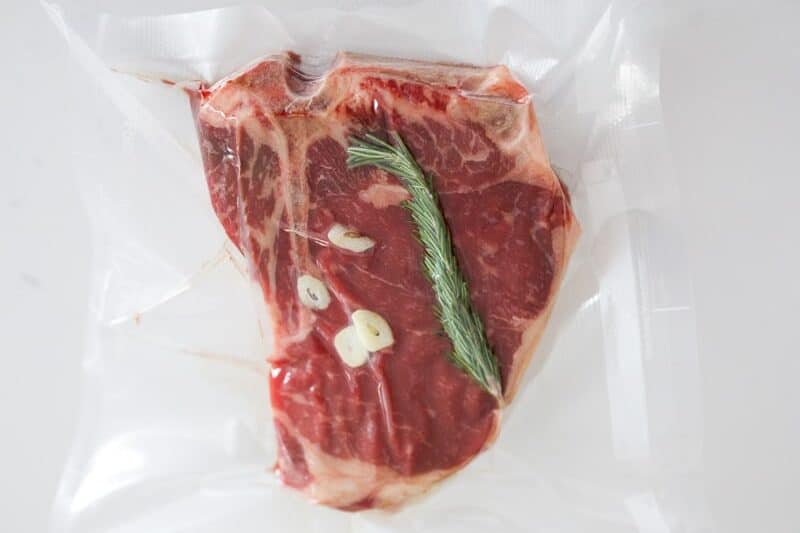
Try this. In a vacuum bag, place a pat of butter with a garlic clove and some sprigs of thyme and or rosemary. Season the steak generously with salt and pepper. Seal the bag and set your immersion circulator.
- For Rare, cook at 120°F
- For Medium Rare, 130°F
- For Medium, 140°F
- For Medium Well, 150°F
Cook for at least 45 minutes and up to 4 hours. The longer the cook, the bigger the change in texture as the muscle fibers break down.
Once your steak has taken its desired bath length and temperature, remove it from the bag and sear it in a hot cast iron pan.
I personally would cook the filet mignon (or tenderloin) at 127°F and the strip steak at 130°F both for 2 hours.
Try both steaks to your liking, cooked separately. But enjoy them side-by-side to experience the best each steak has to offer. No flavor sacrificed.
Both of these steaks are crowd pleasers, each containing the meat of two highly prized steaks each of which are coveted on their own; the filet mignon and strip steak. These steaks rank highly on both our Best Steak for Sous Vide and Most Tender Cut of Steak lists.
Porterhouse & T-Bone Steak FAQs
It’s hard to say which is better, Porterhouse or T-bone. The simple answer is if you’re cooking for one a T-bone is probably the better choice. Porterhouse suits a meal for two well. A Porterhouse is great for special occasions.
The two steaks that make up a porterhouse are a filet mignon and a strip steak. Filet mignon is also called beef tenderloin. Strip steak is also commonly called New York strip or Kansas City strip.
If you’re looking for a decadently rich steak, the ribeye is best. Porterhouse is best if you want two fantastic cuts of meat, a filet mignon and a strip loin (aka New York strip, Kansas City strip), fit to feed two. A T-bone is a great everyday steak.
A porterhouse is more expensive than a T-bone because it contains more tenderloin, the fillet of which is filet mignon. Filet mignon is one of the most expensive cuts of steak.
Yes, a filet mignon is the smaller of the two steak cuts within a porterhouse separated by the T-bone.
A porterhouse is better than a NY strip because a porterhouse contains not only a bone in NY strip, but also a filet mignon.

